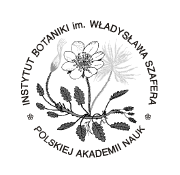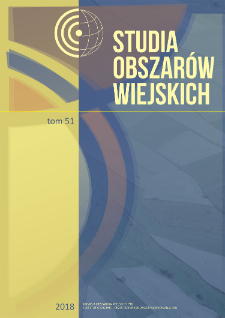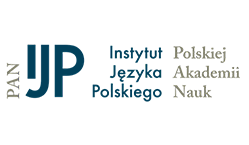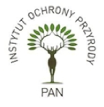- Search in all Repository
- Literature and maps
- Archeology
- Mills database
- Natural sciences
Advanced search
Advanced search
Advanced search
Advanced search
Advanced search

Object
Title: Podłoże teoretyczne podejścia Smart Villages w polityce UE. Perspektywa geograficzna = Theoretical considerations on the Smart Villages approach in the EU Policy: A geographical perspective
Subtitle:
Studia Obszarów Wiejskich = Rural Studies, t. 51
Publisher:
Place of publishing:
Description:
Type of object:
Abstract:
Inteligentne wioski są obecnie dyskutowanym podejściem do rozwoju obszarów wiejskich w ramach polityki unijnej. Uwzględnia ono zróżnicowanie obszarów wiejskich i odmienną specyfikę ich wyzwań rozwojowych, a centralną rolę przypisuje społecznościom lokalnym. W założeniach jego celem jest kształtowanie odpowiednich cech i postaw tychże społeczności umożliwiających tworzenie odpowiednich warunków dla rozwoju, a nie planowanie tego procesu. Podejście to jest rezultatem ewolucji polityki rozwoju obszarów wiejskich, która wynika z kierunku i dynamiki przemian obszarów wiejskich oraz przemian ich społecznego postrzegania. Dlatego celem pracy było ukazanie Smart Villages w kontekście wybranych, współczesnych koncepcji teoretycznych rozwoju obszarów wiejskich. Praca ma charakter teoretyczno-poznawczy. W debacie na temat rozwoju inteligentnego reprezentuje perspektywę geograficzną. Inspirację dla niej stanowiły przemyślenia autorów na temat współczesnej specyfiki rozwoju lokalnego oraz ewolucji polityk dotyczących tego szczebla.
References:
1. Andersson M., Klaesson J., Larsson J.P., 2016, How Local are Spatial Density Externalities? Neighbourhood Effects in Agglomeration Economies, Regional Studies, 50, 6, s. 1082-1095. https://doi.org/10.1080/00343404.2014.968119
2. Baldock D., Dwyer J., Lowe P., Petersen J.E., Ward N., 2001, The nature of rural development: towards a sustainable integrated rural policy in Europe, Institute for European Environmental Policy, London.
3. Bilbao-Osorio B., Rodríguez-Pose A., 2004, From R&D to Innovation and Economic Growth in the EU, Growth and Change, 35, 4, s. 434-455. https://doi.org/10.1111/j.1468-2257.2004.00256.x
4. Bosworth G., 2006, Counterurbanisation and Job Creation: Entrepreneurial In-Migration and Rural Economic Development, Centre for Rural Economy Discussion Paper Series, 4, s. 1-16.
5. Bosworth G., Atterton J., 2012, Entrepreneurial In-migraton and Neoendogenous Rural Development, Rural Sociology, 77, 2, s. 254-279. https://doi.org/10.1111/j.1549-0831.2012.00079.x
6. Boyle P., Halfacree K. (red.), 1998, Migration into Rural Areas: Theories and Issues, Wiley.
7. Bryden J., Dawe S., 1998, Development strategies for remote rural regions: What do we know so far?, http://nibio.academia.edu/johnbryden (data dostępu: listopad 2017).
8. Buttimer A., 1976, Grasping the Dynamism of Lifeworld, Annals of the Association of American Geographers, 66, s. 277-292. https://doi.org/10.1111/j.1467-8306.1976.tb01090.x
9. Cloke P., 2003, Knowing ruralities, [w:] P. Cloke (red.), Country Visions, Pearson, Harlow, s. 1-13.
10. Crouch D., 2006, Tourism, consumption and rurality, [w:] P. Cloke, T. Marsden, P. Mooney (red.), Handbook of Rural Studies, Sage, London, s. 355-364. https://doi.org/10.4135/9781848608016.n25
11. Encyclopedic Dictionary of Landscape and Urban Planning, 2010, Springer-Verlag, Berlin, Heidelberg.
12. EC - European Commission, 2017a, EU Action for Smart Villages, https://ec.europa.eu/agriculture/sites/agriculture/files/rural-development-2014-2020/looking-ahead/rur-dev-small-villages_en.pdf (data dostępu: wrzesień 2018).
13. EC - European Commission, 2017b, Guidelines: Evaluation of LEADER/CLLD, Brussels, https://enrd.ec.europa.eu/file/11452/download_en?token=CwgJOvg5 (data dostępu: październik 2018).
14. ENRD - European Network for Rural Development, 2018, Smart Villages. Revitalising Rural Services, EU Rural Review, 26, Publications Office of the European Union, Luxembourg, https://enrd.ec.europa.eu/sites/enrd/files/enrd_publications/publi-enrd-rr-26-2018-en.pdf (data dostępu: wrzesień 2018).
15. Fagerberg J., Verspagen B., Caniéls M., 1997, Technology, Growth and Unemployment Across European Regions, Regional Studies, 31, 5, s. 457-466. https://doi.org/10.1080/00343409750132252
16. Flyn A., Marsden T., 1995, Guest editorial, Environment and Planning, A, 27, s. 1180-1192. https://doi.org/10.1068/a271180
17. Galdeano-Gómez E., Aznar-Sánchez J.A., Pérez-Mesa J.C., 2011, The Complexity of Theories on Rural Development in Europe: An Analysis of the Paradigmatic Case of Almería (South-east Spain), Sociologia Ruralis, 51, 1, s. 54-78. https://doi.org/10.1111/j.1467-9523.2010.00524.x
18. Green G.P., Haines A., 2012, Asset Building and Community Development, Sage, Los Angeles.
19. Halfacree K., 2006, Rural space: Constructing a three fold architecture, [w:] P. Cloke, T. Marsden, P. Mooney (red.), Handbook of Rural Studies, Sage, London, s. 44-62. https://doi.org/10.4135/9781848608016.n4
20. Halfacree K., 2012, Diverse ruralites in the 21st century: From effacement to (re-)invention, [w:] L.J. Kulcsar, K.J. Curts (red.), Internatonal Handbook of Rural Demography, (International Handbooks of Population, 3), Springer Netherlands, s. 387-400. https://doi.org/10.1007/978-94-007-1842-5_26
21. Herslund L., 2011, The Rural Creative Class: Counterurbanisation and Entrepreneurship in the Danish Countryside, Sociologia Ruralis, 52, 2, s. 235-255. https://doi.org/10.1111/j.1467-9523.2011.00560.x
22. Hoggart K., 1990, Let's do away with rural, Journal of Rural Studies, 6, s. 245-257. https://doi.org/10.1016/0743-0167(90)90079-N
23. Kaleta A., 1992, Podstawowe założenia odnowy obszarów wiejskich Europy, [w:] M. Wieruszewska (red.), Odnowa wsi. Między mitem a nadzieją, Instytut Rozwoju Wsi i Rolnictwa Polskiej Akademii Nauk, Warszawa, s. 13-46.
24. Koster H.R.A., van Ommeren J., Rietveld P., 2014, Is the Sky the Limit? High-Rise Buildings and Office Rents, Journal of Economic Geography, 14, 1, s. 125-153. https://doi.org/10.1093/jeg/lbt008
25. Lowe P., Murdoch J., Ward N., 1995, Networks in rural development beyond exogenous and endogenous models, [w:] J.D. van der Ploeg, G. Dijk (red.), Beyond modernisation: The impact of endogenous rural development, Van Gorcum, Assen, s. 87-105.
26. Marsden T., 1999, Rural futures: The consumption countryside and its regulation, Sociologia Ruralis, 39, s. 501-520. https://doi.org/10.1111/1467-9523.00121
27. McArdle K., 2012, What makes a successful rural regeneration partnership? The views of successful partners and the importance of ethos for the community development professional, Community Development, 43, 3, s. 333-345. https://doi.org/10.1080/15575330.2011.621211
28. McCann P., Ortega-Argilés R., 2015, Smart Specialization, Regional Growth and Applications to European Union Cohesion Policy, Regional Studies, 49, 8, s. 1291-1302. https://doi.org/10.1080/00343404.2013.799769
29. McKibbon A.K., 2006, Systematic Reviews and Librarians, Library Trends, 55, 1, s. 202-215. https://doi.org/10.1353/lib.2006.0049
30. Morris A., 1998, Geography and Development, UCL Press, London.
31. Murdoch J., Pratt A., 1993, Rural studies: Modernism, postmodernism and the "post rural", Journal of Rural Studies, 9, s. 411-427. https://doi.org/10.1016/0743-0167(93)90053-M
32. Murray M., Dunn L., 1996, Capacity building for rural development in the United States, Journal of Rural Studies, 1, 1, s. 89-97. https://doi.org/10.1016/0743-0167(94)00056-F
33. Naldi L., Nilsson P., Westlund H., Wixe S., 2015, What is samrt rural development?, Journal of Rural Studies, 40, s. 90-101. https://doi.org/10.1016/j.jrurstud.2015.06.006
34. OECD, 2006, The New Rural Paradigm. Policies and Governance, OECD: Paris.
35. Picchi A., 1994, The relations between central and local powers as context for endogenous development, [w:] J.D. van der Ploeg, A. Long, (red.), Born from within: Practice and Perspectives of Endogenous Rural Development, Van Gorcum, Assen, s. 195-203.
36. Rauch J.E., 1993, Productivity Gains from Geographic Concentration of Human Capital: Evidence from the Cities, Journal of Urban Economics, 34, 3, s. 380-400. https://doi.org/10.1006/juec.1993.1042
37. Ray Ch., 2000, Endogenous socio-economic development in the European union - issues of evaluation, Journal of Rural Studies, 16, s. 447-458. https://doi.org/10.1016/S0743-0167(00)00012-7
38. Ray Ch., 2001, Culture Economies: A perspective on local rural development in Europe, Centre for Rural Economy, https://www.ncl.ac.uk/media/wwwnclacuk/centreforruraleconomy/files/culture-economy.pdf (data dostępu: wrzesień 2018).
39. Relph E., 1976, Place and Placelessness, Pion, London.
40. Romer P.M.,1990, Endogenous technological change, Journal of Political Economy, 98, 5, s. 71-102. https://doi.org/10.1086/261725
41. Slee B., 1994, Theoretical aspects of the study of endogenous development, [w:] J.D. van der Ploeg, A. Long, (red.), Born from within: Practice and Perspectives of Endogenous Rural Development, Van Gorcum, Assen, s. 184-194.
42. Stockdale A., 2005, Incomers: Offering economic potential in rural England, Journal of the Royal Agricultural Society of England, 166, s. 1-5.
43. Stockdale A., 2006, Migration: Pre-requisite for rural economic regeneration?, Journal of Rural Studies, 22, s. 354-366. https://doi.org/10.1016/j.jrurstud.2005.11.001
44. Terluin I.J., 2003, Differences in economic development in rural regions of advanced countries: an overview and critical analysis of theories, Journal of Rural Studies 19, s. 327-344. https://doi.org/10.1016/S0743-0167(02)00071-2
45. Tuan Y.-F., 1987, Przestrzeń i miejsce (tłum. A. Morawińska), Państwowy Instytut Wydawniczy, Warszawa.
46. van der Ploeg J.D., Renting H., Brunori G., Knickel K., Mannion J., Marsden T., de Roest K., Sevilla-Guzmán E., Ventura F., 2000, Rural Development: From Practices and Policies towards Theory, Sociologia Ruralis, 40, 4, s. 391-408. https://doi.org/10.1111/1467-9523.00156
47. Ward N., Atterton J., Kim T.-Y., Lowe P., Phillipson J., Thompson N., 2005, Universities, the Knowledge Economy and 'Neo-Endogenous Rural Development', Centre for Rural Economy Discussion Paper Series, 1, s. 1-15.
48. Ward N., Brown D., 2009, Placing the Rural in Regional Development, Regional Studies, 43, 10, s. 1237-1244. https://doi.org/10.1080/00343400903234696
49. Wierzbicki Z., 1970, Aktywizacja społeczności lokalnych (Stosowana socjologia wsi), [w:] A.L. Bertrand, Z. Wierzbicki (red.), Socjologia wsi w Stanach Zjednoczonych, Zakład Narodowy im. Ossolińskich, Wydawnictwo Polskiej Akademii Nauk, Wrocław, Warszawa, Kraków.
50. Wolski O., 2018, The Place of Rural Areas in Regional Development Concepts and Processes, [w:] P. Nijkamp, K. Kourtit (red.), Rurality in an Urbanized World, Shaker, Maastricht/Aachen (w druku).
51. Wolski O., 2018, Smart Villages in the EU policy: How to Match Innovativeness and Pragmatism?, Wieś i Rolnictwo, 4, 181, s. 163-179.
52. Wójcik M., 2012, Geografia wsi w Polsce. Studium zmiany podstaw teoretyczno-metodologicznych, Wydawnictwo Uniwersytetu Łódzkiego, Łódź. https://doi.org/10.18778/7525-657-4
53. Wójcik M., 2013, Przemiany społeczno-przestrzenne osiedli wiejskich. Studium przypadku Łódzkiego Obszaru Metropolitalnego, Wydawnictwo Uniwersytetu Łódzkiego, Łódź. https://doi.org/10.18778/7969-047-3
54. Wójcik M., (red.), 2018, Inteligentny rozwój obszarów wiejskich (smart rural development): koncepcja, wymiary, metody, Global Point, Łódź.
Relation:
Volume:
Start page:
End page:
Detailed Resource Type:
Format:
Rozmiar pliku 0,3 MB ; application/octet-stream
Resource Identifier:
oai:rcin.org.pl:75334 ; 1642-4689 ; 10.7163/SOW.51.8
Source:
CBGiOŚ. IGiPZ PAN, sygn. Cz.4488 ; CBGiOŚ. IGiPZ PAN, sygn. Cz.4489 ; click here to follow the link
Language:
Language of abstract:
Rights:
Licencja Creative Commons Uznanie autorstwa 4.0
Terms of use:
Zasób chroniony prawem autorskim. [CC BY 4.0 Międzynarodowe] Korzystanie dozwolone zgodnie z licencją Creative Commons Uznanie autorstwa 4.0, której pełne postanowienia dostępne są pod adresem: ; -
Digitizing institution:
Instytut Geografii i Przestrzennego Zagospodarowania Polskiej Akademii Nauk
Original in:
Projects co-financed by:
Access:
Object collections:
- Digital Repository of Scientific Institutes > Partners' collections > Institute of Geography and Spatial Organization PAS (IGiPZ PAN) > Publications of IGiPZ PAN and employees
- Digital Repository of Scientific Institutes > Partners' collections > Institute of Geography and Spatial Organization PAS (IGiPZ PAN) > Library > Series/Journals/Periodics
- Digital Repository of Scientific Institutes > Literature > Books/Chapters
- Digital Repository of Scientific Institutes > Literature > Journals/Articles
Last modified:
Mar 25, 2021
In our library since:
Jul 19, 2019
Number of object content downloads / hits:
1633
All available object's versions:
https://rcin.org.pl./publication/98003
Show description in RDF format:
Show description in RDFa format:
Show description in OAI-PMH format:
Objects Similar
Wolski, Oskar
Wolski, Oskar Sykała, Łukasz
Zwolińska-Ligaj, Magdalena Guzal-Dec, Danuta Adamowicz, Mieczysław
Cotella, Giancarlo

 INSTYTUT ARCHEOLOGII I ETNOLOGII POLSKIEJ AKADEMII NAUK
INSTYTUT ARCHEOLOGII I ETNOLOGII POLSKIEJ AKADEMII NAUK
 INSTYTUT BADAŃ LITERACKICH POLSKIEJ AKADEMII NAUK
INSTYTUT BADAŃ LITERACKICH POLSKIEJ AKADEMII NAUK
 INSTYTUT BADAWCZY LEŚNICTWA
INSTYTUT BADAWCZY LEŚNICTWA
 INSTYTUT BIOLOGII DOŚWIADCZALNEJ IM. MARCELEGO NENCKIEGO POLSKIEJ AKADEMII NAUK
INSTYTUT BIOLOGII DOŚWIADCZALNEJ IM. MARCELEGO NENCKIEGO POLSKIEJ AKADEMII NAUK
 INSTYTUT BIOLOGII SSAKÓW POLSKIEJ AKADEMII NAUK
INSTYTUT BIOLOGII SSAKÓW POLSKIEJ AKADEMII NAUK
 INSTYTUT CHEMII FIZYCZNEJ PAN
INSTYTUT CHEMII FIZYCZNEJ PAN
 INSTYTUT CHEMII ORGANICZNEJ PAN
INSTYTUT CHEMII ORGANICZNEJ PAN
 INSTYTUT FILOZOFII I SOCJOLOGII PAN
INSTYTUT FILOZOFII I SOCJOLOGII PAN
 INSTYTUT GEOGRAFII I PRZESTRZENNEGO ZAGOSPODAROWANIA PAN
INSTYTUT GEOGRAFII I PRZESTRZENNEGO ZAGOSPODAROWANIA PAN
 INSTYTUT HISTORII im. TADEUSZA MANTEUFFLA POLSKIEJ AKADEMII NAUK
INSTYTUT HISTORII im. TADEUSZA MANTEUFFLA POLSKIEJ AKADEMII NAUK
 INSTYTUT JĘZYKA POLSKIEGO POLSKIEJ AKADEMII NAUK
INSTYTUT JĘZYKA POLSKIEGO POLSKIEJ AKADEMII NAUK
 INSTYTUT MATEMATYCZNY PAN
INSTYTUT MATEMATYCZNY PAN
 INSTYTUT MEDYCYNY DOŚWIADCZALNEJ I KLINICZNEJ IM.MIROSŁAWA MOSSAKOWSKIEGO POLSKIEJ AKADEMII NAUK
INSTYTUT MEDYCYNY DOŚWIADCZALNEJ I KLINICZNEJ IM.MIROSŁAWA MOSSAKOWSKIEGO POLSKIEJ AKADEMII NAUK
 INSTYTUT PODSTAWOWYCH PROBLEMÓW TECHNIKI PAN
INSTYTUT PODSTAWOWYCH PROBLEMÓW TECHNIKI PAN
 INSTYTUT SLAWISTYKI PAN
INSTYTUT SLAWISTYKI PAN
 SIEĆ BADAWCZA ŁUKASIEWICZ - INSTYTUT TECHNOLOGII MATERIAŁÓW ELEKTRONICZNYCH
SIEĆ BADAWCZA ŁUKASIEWICZ - INSTYTUT TECHNOLOGII MATERIAŁÓW ELEKTRONICZNYCH
 MUZEUM I INSTYTUT ZOOLOGII POLSKIEJ AKADEMII NAUK
MUZEUM I INSTYTUT ZOOLOGII POLSKIEJ AKADEMII NAUK
 INSTYTUT BADAŃ SYSTEMOWYCH PAN
INSTYTUT BADAŃ SYSTEMOWYCH PAN
 INSTYTUT BOTANIKI IM. WŁADYSŁAWA SZAFERA POLSKIEJ AKADEMII NAUK
INSTYTUT BOTANIKI IM. WŁADYSŁAWA SZAFERA POLSKIEJ AKADEMII NAUK




































